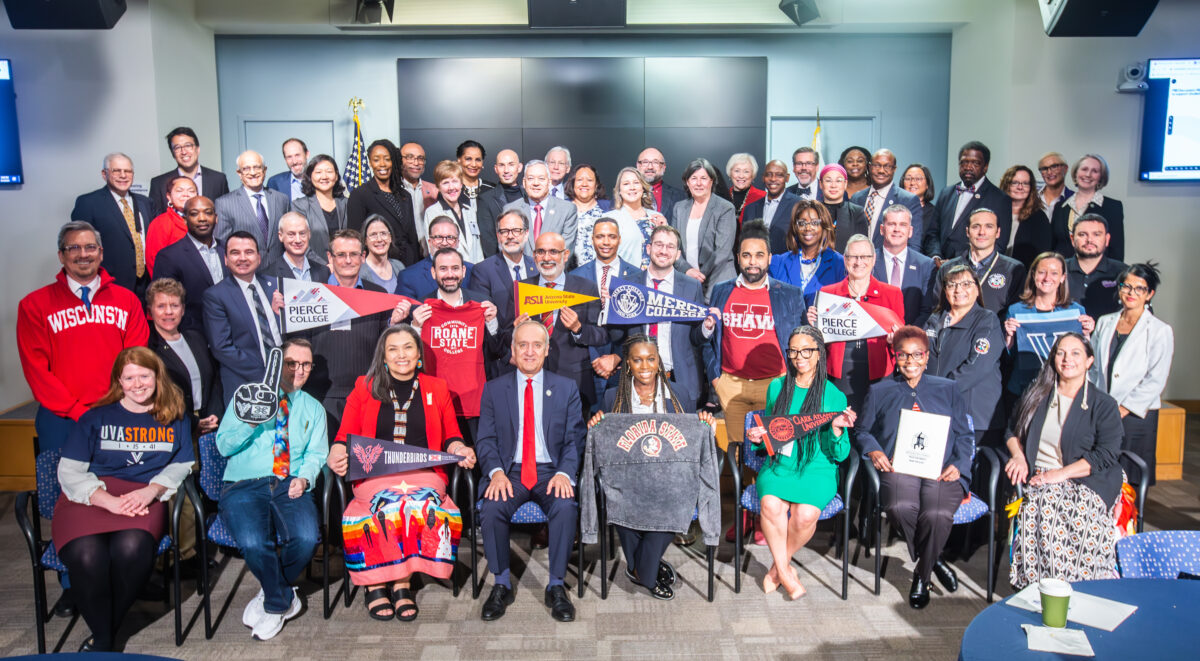“Behind every data point is a student.” Reflections on ED’s Raise the Bar Summit


When U.S. Secretary of Education Miguel Cardona welcomed postsecondary leaders, researchers, and student success advocates to the U.S. Department of Education’s (ED) recent Raise the Bar Summit, he framed what it truly means to be a prestigious institution of higher education. Yet, the institutions that are “raising the bar” and deserving of glory are often unheralded. These institutions are catalyzing economic mobility for the very students who are too often left behind by our higher education system, and doing so without much fanfare.
It was an honor to be among summit attendees from across the country, including a number of those prestigious institutions who are boosting opportunity and mobility for today’s students. We heard from agency leaders including Secretary Cardona, Undersecretary of Education James Kvaal, and Assistant Secretary for Postsecondary Education Nasser Paydar about the scope of the challenges facing our postsecondary system and the power of the colleges and experts convened to tackle those challenges through a combination of intentional data-use strategies, committed leadership, and an unyielding commitment to student success.
The day’s conversations included inspiring reflections and honest accounts about challenges with accessing and using data to promote student success. There was a shared understanding that data can be a powerful tool for institutional leaders seeking to strengthen interventions, state leaders who want to better understand attainment trends, and federal leaders hoping to empower students, families, and policy researchers with more information about college outcomes. But there is more we can do to strengthen the quality of available data and instill a culture of data use among decision makers.
I had the pleasure of moderating a panel discussion focused on identifying key metrics to incentivize institutional improvements and student outcomes. Panelists included two field leaders who are putting postsecondary data into action: Mushtaq Gunja, Executive Director, Carnegie Classification Systems and Senior Vice President at the American Council on Education and David Troutman Deputy Commissioner for Academic Affairs and Innovation for the Texas Higher Education Coordinating Board. Together we discussed how to leverage data to diagnose inequities and identify effective interventions.
A few key themes emerged from that panel and the day’s conversations…
- Creating a culture of data use takes commitment. Colleges and universities that have moved the needle on student outcomes have done so through the intentional use of data. But embedding data-use practices requires culture shifts. Instead of relying on longstanding student support programs or assessing outcomes on an annual basis, more deliberate and timely data review can drive program improvements, and in turn, improve student outcomes. Federal and state leaders can also help institutions by removing administrative barriers and providing the financial resources necessary to do this work.
- Disaggregated data can shine a light on inequities and engage proximate communities. The summit featured repeated calls for disaggregated data to inform policy and practice, especially data disaggregated by race/ethnicity and Pell Grant recipient status. Advocates emphasized the critical need for disaggregated data to understand outcomes for Indigenous students, who are so often overlooked in policy conversations. And beyond simply collecting data, it’s important to involve communities of color in decisions about how to use their data.
- Don’t silo institutional research. Participants also discussed the importance of embedding institutional research and building data capacities throughout campuses, rather than isolating data activities to one office. Institutional research can support campuswide student success efforts by offering real-time data-informed insights.
- High quality data can support efforts to provide equitable value to all students. The evidence is abundantly clear: a college degree can help graduates secure economic mobility, especially for students living with low incomes and students of color who have been underrepresented in postsecondary settings. But as questions are raised about the return on investment for specific institutions or programs, it’s increasingly important to consider how data can drive equitable postsecondary value. The summit drew upon lessons from IHEP research including the Postsecondary Value Commission which developed a clear definition, measurement framework, and action agenda around improving postsecondary value.
It was heartening to learn of ED’s plans to make more administrative data available for institutional improvement and research efforts. Jordan Matsudaira, Deputy Undersecretary and Chief Economist at ED, shared what’s to come including more real-time data on enrollment and completion, data on the share of students staying in state after graduation, transfer success by destination and peer groupings of campuses.
I applaud ED for creating space for policymakers and institutional leaders to discuss the importance of using data to improve student success and educational equity. These conversations were especially energizing following the reintroduction of the College Transparency Act which was announced just days before.
At IHEP, we are committed to working with leaders across the postsecondary community to support these efforts. We’ve developed resources, including a data Metrics Framework, that details the basics of postsecondary data collection, analysis, and changemaking and can serve as a foundational tool for institutions, systems, states, and initiatives in deciding what data to collect and how to define it.
And while talking about systems and data at a day-long summit is important, every participant’s motivating priority is supporting student success. Senior Advisor at the Department of Education Jennifer Engle put it succinctly: “Behind every data point is a student.” High quality data, when used with intention, can indeed raise the bar for student success.
###
Learn more about IHEP’s efforts to promote equitable student access and success through data in Towards Convergence: A Technical Guide for the Postsecondary Metrics Framework and read the Postsecondary Value Commission’s final report and executive summary here.
IHEP convenes the Postsecondary Data Collaborative, a coalition of organizations leading the way in the use of high-quality postsecondary data.


